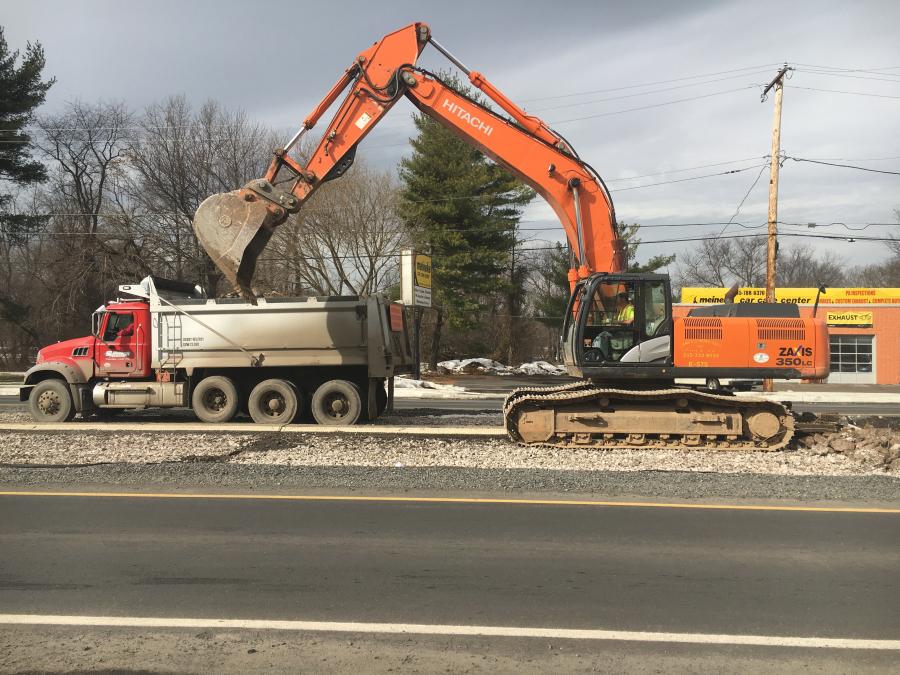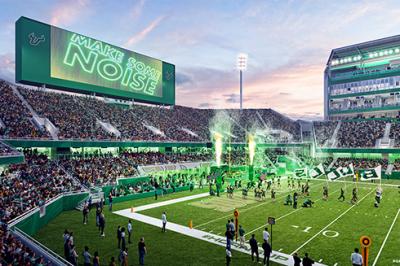The majority of the work has had 25 to 30 James D. Morrissey and subcontractor employees on site during peak construction season days.
PennDOT photo. The Pennsylvania Department of Transportation is working on a $36.5 million project to enhance travel and safety along a 4.3-mi. (7 km) stretch of U.S. 13 (Bristol Pike).
The Pennsylvania Department of Transportation is working on a $36.5 million project to enhance travel and safety along a 4.3-mi. (7 km) stretch of U.S. 13 (Bristol Pike) between Route 413 and Levittown Parkway in Bristol Township, Bristol Borough and Tullytown Borough.
Construction began in January 2013.
PennDOT's contractor, James D. Morrissey, Inc. (JDM), is rehabilitating the roadway's deteriorated pavement; replacing drainage facilities that date back to the 1940s, which is a significant improvement as this is a relatively low-lying area close to the Delaware River and the Delaware Canal; building sidewalks for pedestrian travel; modernizing traffic signals; installing medians; removing jug handles; reducing travel speeds; and implementing traffic calming measures.
In December 2015, crews completed the northern section between Green Lane and Levittown Parkway. They also rehabilitated the aging pavement and replaced old drainage facilities; modernized traffic signals; narrowed the roadway's six-lane section to four lanes and reduced the speed limit from 50 mph to 45 mph; added an 18-ft. (5.5 m) wide center median; installed left turn lanes at Haines Road, Edgely Avenue and Levittown Parkway; removed the jug handles on U.S. 13 at the SEPTA Levittown Train Station and Haines Road; and converted the U.S. 13 northbound jug handle at Levittown Center Driveway to a turn-around for large vehicles.
On the southern end of the project, from Route 413 to Green Lane, the contractor is working to complete the full depth reconstruction of the left lanes, while also installing new drainage in the median.
The project includes the installation of 32,000 ft. (9,754 m) of median curb to create a grass-median in the center of U.S. 13 to separate northbound and southbound traffic. Additionally the contract calls for 47,000 ft. (14,325 m) of concrete curb and 15,000 sq. yds. (12,542 sq m) of new sidewalk to improve pedestrian access through the corridor.
The work also includes $2 million to replace the bridge over Otter Creek and $300,000 for rehabilitating the structure over Adams Hollow Creek. The work began with the installation of more than 20,000 ft. (6,096 m) of new drainage pipes under U.S. 13 between Green Lane and Levittown Parkway, where the existing road was three lanes in each direction for approximately 2 mi. (3.2 km). South of Green Lane the road narrows to two lanes in each direction.
Prior to the work, the road handled 36,228 vehicles daily and has been designed to accommodate future traffic growth for approximately 48,000 vehicles by 2034. The new roadway should have a lifespan of 50 years, with resurfacing every eight to ten years.
“The U.S. 13 (Bristol Pike) improvement plan incorporated recommendations from the U.S. 13 Revitalization Committee,” said Charles Metzger, PennDOT's community relations coordinator. “The project is also designed to spur economic development in the region by creating a more attractive boulevard setting and provide pedestrian access.”
“Prior to construction none of the businesses had curbed driveway access — they were just open to the street and there was no safe place for pedestrians walking along U.S. 13,” he added. “There's no designated bike lane, but we worked in conjunction with the Pennsylvania Department of Conservation and Natural Resources, which oversees the Delaware Canal and maintains a trail which follows the canal and will now cross under U.S. 13 near Green Lane.”
PennDOT's construction engineer responsible for the project is Edward Burns. Tom Kerins, with Urban Engineers, is serving as PennDOT's consultant construction manager and Pennoni Associates is assisting PennDOT with project inspection services.
Kerins noted that the drainage system improvements include the installation of several stormwater management basins that are crucial to ensuring that the water is properly retained and treated before being released into the canal and surrounding waterways.
The project also is addressing several traffic safety concerns to meet current PennDOT and Federal Highway Administration design standards such as adequate sight distance and proper super-elevation requirements for curved sections of the corridor.
While the U.S. 13 project is not directly linked to the current PennDOT/Turnpike Interchange Project at I-95 and U.S. 1, there is a relationship between the two projects.
“The benefit of that project is that it will take a lot of truck traffic directly from I-95 onto the turnpike,” said Kerins, “and alleviate future heavy truck traffic on this section of U.S. 13.”
Kerins said that the sub-surface drainage work was the biggest challenge for the project, since some of the new 54 in. (137 cm) pipes were installed 20 ft. (6 m) below the road surface. Installing new underground infrastructure through a fully developed urban area, with potential conflicts with underground utility lines — electric duct banks, telephone lines, gas lines and local water and sewer lines is complex and time consuming.
“You have a completely built-out and aged infrastructure and we're introducing new storm drains,” he said, “so there was a considerable amount of utility coordination. The utility companies were cooperative, but we encountered several utilities that were not marked on the maps and we had to develop a number of drainage revisions to avoid conflicts with utilities that could not be relocated.”
James D. Morrissey Inc., based in Philadelphia, assigned Scott Rainey as its project manager and Chris Bunda is the project superintendent.
“There hasn't been anything easy about this job,” said Kerins. “Each construction section is just over two miles long and each section has to be rebuilt in two phases. The reason we are proceeding this way is that there are a significant number of businesses and residences along the corridor and access had to be maintained at all times during the construction. Any time you have a construction zone in front of your business, it can affect business. PennDOT has worked with local businesses to lessen the impacts of this project. Business owners know they can always call us and we'll meet with them to see if something can be done to accommodate their needs. We can't always change the design, but if we can do something to improve their access, we will.”
The majority of the work has had 25 to 30 James D. Morrissey and subcontractor employees on site during peak construction season days. The main subcontractors are: Nyleve Bridge Corporation for bridges; Prieto Corporation for curbs and sidewalks; Armour & Sons Electric Inc. for traffic signals and ITS devices; L & R Construction for reinforcing steel; and All Seasons Landscaping Co. Inc. for wetland plantings and landscaping.
On this project, more than 180,000 cu. yds. (137,620 cu m) of material was excavated and removed from the project. New materials consist of approximately 457,000 sq. yds. (382,110 sq m) of bituminous paving, 35,000 ft. (10,668 m) of pipe, 15,000 sq. yds. (12,542 sq m) of sidewalk, 47,000 ft. (14,326 m) of curb, 32,000 ft. of median curb, 12,000 sq. yds. (10,033.5 sq m) of concrete paving, 160,000 lbs. (72,575 kg) of reinforcement steel and 17,000 cu. yds. (12,997 cu m) of topsoil.
Kerins said that the field staff for PennDOT and the contractor “work well together and react quickly to resolve unforeseen changes in their work environment. The project team responds to challenges with innovative solutions and maintains good communications. The contractor developed a critical path method (CPM) schedule for the project, which they update on a monthly basis, and they're progressing according to their project schedule.”
He also noted that this project has demonstrated the “the importance of doing even more sub-surface utility investigations during design to identify, in advance of construction, the location of utility lines. The field forces are doing more utility investigations and coordination in advance of future operations and that is making a difference now. This is not a standard production job, since we're installing new cross-pipes, inlets, manholes and drainage structures while maintaining traffic in multiple stages. It's just a matter of getting further out in front of potential conflicts so they can be resolved without impacting construction. For the most part we are out of the ground and engaged in the final phase of roadway construction, including grading, paving, curbs and sidewalks. This work goes pretty quickly and people are generally happy when a section of road is done.
“The businesses have struggled with construction for two or three years,” he added. “It's been difficult for them. Hopefully, their businesses will flourish once construction is completed and the corridor is made safer and more accessible for pedestrians and the traveling public.”
Irwin Rapoport
A journalist who started his career at a weekly community newspaper, Irwin Rapoport has written about construction and architecture for more than 15 years, as well as a variety of other subjects, such as recycling, environmental issues, business supply chains, property development, pulp and paper, agriculture, solar power and energy, and education. Getting the story right and illustrating the hard work and professionalism that goes into completing road, bridge, and building projects is important to him. A key element of his construction articles is to provide readers with an opportunity to see how general contractors and departments of transportation complete their projects and address challenges so that lessons learned can be shared with a wider audience.
Rapoport has a BA in History and a Minor in Political Science from Concordia University. His hobbies include hiking, birding, cycling, reading, going to concerts and plays, hanging out with friends and family, and architecture. He is keen to one day write an MA thesis on military and economic planning by the Great Powers prior to the start of the First World War.
Read more from Irwin Rapoport here.
Today's top stories


















